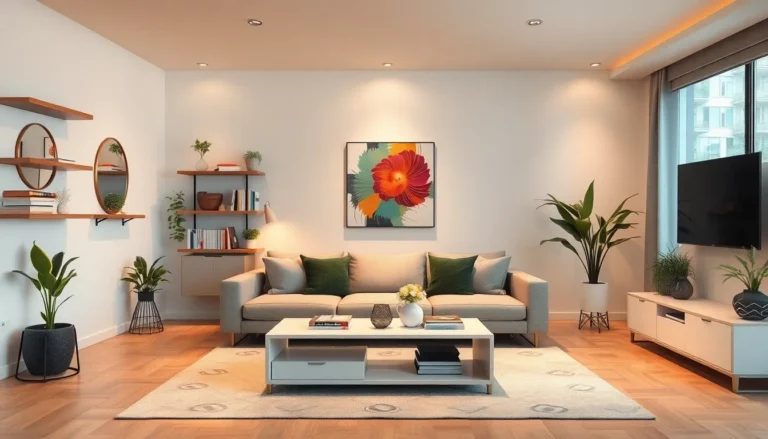When it comes to luxury interior design, it’s not just about picking the fanciest furniture or the shiniest decor. It’s about creating a space that whispers elegance while still making you feel right at home. Imagine walking into a room that feels like a five-star hotel but also has your favorite cozy blanket draped over the couch. That’s the sweet spot luxury design aims for.
In a world where everyone’s trying to outdo each other with the latest trends, it’s easy to get lost in the chaos. But true luxury isn’t about keeping up; it’s about crafting a sanctuary that reflects personal style and sophistication. So buckle up as we dive into the world of luxury interior design, where every detail counts and comfort meets opulence in the most delightful ways.
Table of Contents
ToggleUnderstanding Interior Design Luxury
Luxury interior design embodies more than mere aesthetics; it focuses on an experience that resonates with elegance and comfort. Designers emphasize the necessity of creating environments that evoke a five-star hotel feel while still maintaining a sense of homeliness. Personal style anchors the concept of luxury, showcasing individual preferences amid a sea of market trends.
Attention to detail becomes paramount in these spaces. Each accessory, fabric, and piece of furniture is meticulously chosen to enhance the overall ambiance. Notably, the interplay between textures and colors plays a crucial role in achieving the desired sophistication.
A balance between comfort and opulence should exist. Spacious layouts often feature plush seating arrangements that invite relaxation yet remain visually striking. Natural elements, such as wood and stone, integrate seamlessly, offering both warmth and luxury.
Unique art pieces contribute to luxury design as well. They serve as focal points that elevate the overall aesthetic. Customization often reflects the homeowner’s individuality, ensuring that luxury aligns with personal narratives.
Designers strive to create sanctuaries that cater to the senses. Soft lighting, fragrant materials, and carefully selected color palettes evoke a comforting atmosphere. Each element collaborates to establish a harmonious environment that stands apart from ordinary design.
Creating luxury interiors demands an ongoing commitment to quality and uniqueness. Styles continuously evolve, yet the essence of true luxury remains timeless, reflecting both heritage and innovation. In essence, luxury in interior design transforms spaces into personal retreats that balance sophistication with comfort.
Key Elements of Luxury Interior Design
Creating a luxurious interior involves several key components that work in harmony to establish an elegant atmosphere.
Color Palettes
Neutral hues often dominate luxury spaces, establishing a calming effect that enhances elegance. Soft whites, beiges, and grays serve as a foundation, allowing more vibrant accent colors to shine. Rich jewel tones, such as emerald greens or deep blues, add depth and personality to rooms. Color combinations should reflect the homeowner’s taste while ensuring a cohesive look. Using color to highlight architectural features or enhance furnishings creates an inviting ambiance.
Materials and Textures
High-quality materials define luxury interiors, emphasizing both aesthetics and tactile experience. Natural stones like marble or granite contribute sophistication and durability. Luxurious fabrics, including silk, velvet, and cashmere, elevate comfort and visual appeal. Combining various textures adds richness, fostering a multisensory environment. Incorporating metals such as brass or gold in accents and fixtures enhances the overall allure. Every material choice reflects a commitment to quality, ensuring the space feels opulent and refined.
Trends in Luxury Interior Design
Luxury interior design embraces evolving trends that enhance both aesthetics and functionality. Contemporary movements focus on sustainability and innovative technology, shaping luxurious experiences.
Sustainable Luxury
Sustainable luxury prioritizes eco-friendly materials and responsible sourcing. Designers select reclaimed wood and recycled metals to reduce environmental impact. Organic textiles contribute to a health-conscious living environment. Spaces now beautifully blend luxury with environmental responsibility, showcasing craftsmanship that respects nature. Greenery also finds its place, with indoor plants creating a calming atmosphere. Sustainability reflects a growing awareness in luxury markets, appealing to conscientious consumers.
Smart Home Technology
Smart home technology integrates seamlessly into luxury spaces, enhancing convenience. Automated lighting systems adjust to individual moods, while climate control systems optimize comfort. Voice-activated devices streamline everyday tasks, merging luxury with modern living. Security systems showcase sophistication through cutting-edge technology that ensures safety. Multimedia systems deliver entertainment at the touch of a button, transforming spaces into high-tech retreats. Luxury now embraces innovation, making homes not just beautiful but also intelligently designed.
Iconic Luxury Interior Design Styles
Luxury interior design encompasses various iconic styles that resonate with sophistication and elegance. Each style represents unique elements and thoughtfully curated aesthetics.
Modern Luxury
Modern luxury emphasizes clean lines, open spaces, and minimalism. It showcases sleek furniture and cutting-edge designs that create a sleek environment. Neutral tones dominate these spaces, often accented with bold colors for visual interest. The balance between form and function invites both style and comfort, allowing for seamless living and sophisticated entertaining. Incorporating innovative materials such as glass and metal enhances this modern aesthetic. High-end technologies often integrate into the design, providing convenience and an upscale feel. Unique artworks, smart appliances, and statement light fixtures add personality and flair.
Classic Luxury
Classic luxury embodies a timeless elegance through traditional furnishings and ornate details. Rich color palettes, including deep reds and golds, evoke opulence and warmth. Detailed woodwork and intricate moldings define these spaces, showcasing craftsmanship and heritage. High-quality textiles like silk and velvet create inviting textures throughout. Antique pieces often serve as focal points, connecting the past with the present. Formal layouts emphasize symmetry and balance, enhancing sophistication. Curated art collections and vintage decor pieces contribute to the distinctive character, making each room feel unique while maintaining a cohesive overall design.
Tips for Creating a Luxurious Space
In luxury interior design, the choice of materials holds significant importance. High-quality fabrics like silk or velvet provide an opulent feel. Incorporating natural stones, such as marble or granite, enhances visual interest while delivering durability.
Light plays a vital role in creating luxurious atmospheres. Soft, warm lighting creates a sense of comfort and elegance. Strategically placed fixtures can transform the mood, emphasizing architectural features and textures.
Art pieces should serve as focal points within the space. Unique sculptures or paintings capture attention and showcase individual style. Customizable options allow homeowners to express their personal tastes, reinforcing a sense of identity.
Comfort deserves equal consideration alongside aesthetics. Plush seating arrangements invite relaxation, encouraging social interactions. Arranging furniture to facilitate flow promotes a welcoming environment while maintaining visual harmony.
Using a cohesive color palette establishes a serene vibe. Neutral tones provide a calming backdrop, while jewel tones introduce depth and character. Balancing these colors throughout the space offers a sophisticated yet inviting atmosphere.
Textures contribute to the overall sensory experience. Mixing materials, like soft fabrics with sleek metals, adds dimension to the design. Thoughtfully layering textures creates a multisensory ambiance that invites exploration.
Sustainability is gaining traction in luxury interior design. Opting for eco-friendly materials reflects a commitment to responsible living. Reclaimed wood and organic textiles serve as excellent choices, enhancing both aesthetics and sustainability.
Lastly, integrate smart home technology to elevate comfort and convenience. Automation for lighting and climate control simplifies daily living while complementing luxurious interiors. Combining these modern features with timeless design principles creates an environment suitable for contemporary lifestyles.
Luxury interior design transcends mere aesthetics. It’s about crafting spaces that resonate with personal style while embodying comfort and elegance. By focusing on quality materials and thoughtful details, anyone can create a sanctuary that reflects sophistication and warmth.
Incorporating sustainable elements and smart technology not only enhances convenience but also aligns with modern living. The interplay of textures and colors contributes to a multisensory experience that invites relaxation.
Ultimately, luxury is a deeply personal journey. It invites individuals to express their unique tastes while embracing timeless design principles that elevate everyday living.








